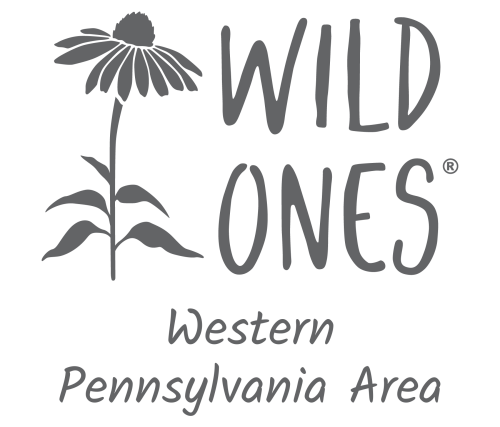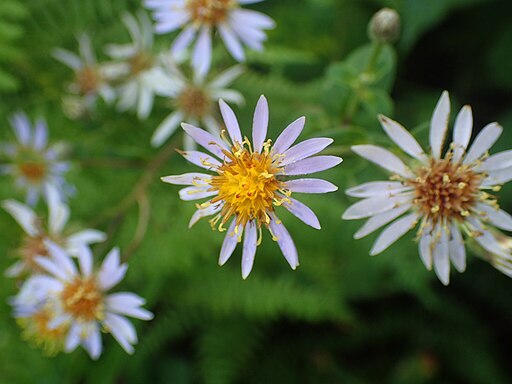American-asters, those in the Symphyotrichum genus, as opposed to the European asters, those in the Aster genus, are one of the most common flowers in the late summer and autumn. These plants serve as host plants for the Pearl Crescent (Phyciodes tharos), American Lady (Vanessa virginiensis), and silvery checkerspot (Chlosyne nycteis) butterflies as well as several moths. The genus name, Symphyotrichum, is a combination of “symphysis” (hair) and “thriks” (together), which when combined mean hair growing together (Wikipedia), referring to the pappus of the seeds. Generally the species discussed here are perennials, although some species can be annuals. The most common American-asters native to western Pennsylvania, hereby shortened to “aster”, are below.
General Information about Native Plant and Pollinator Gardens
When planting a native plant and pollinator garden in Allegheny County, PA, you need to ensure that you have a selection of plants that attract other butterflies at different time of the year. Besides asters, other host plants that attract other butterflies and pollinators should be considered. These could include pawpaw (Asimina triloba) for zebra swallowtail, wild cherry (Prunus serotina) for eastern tiger swallowtails, and trumpet creeper (Campsis radicans) for hummingbirds.
In addition to the plants, you need to provide a source of water such as a birdbath or water feature, shelter for animals, and nesting locations for birds. Be sure to include plants of different heights for perching. Resources you can use for more information on butterfly gardening in Allegheny County include the Penn State Master Gardeners of Allegheny County, Wild Ones Western Pennsylvania Chapter, Audubon Society of Western Pennsylvania, Xerces Society, and Phipps Conservatory and Botanical Garden.
Location of Allegheny County, Pennsylvania
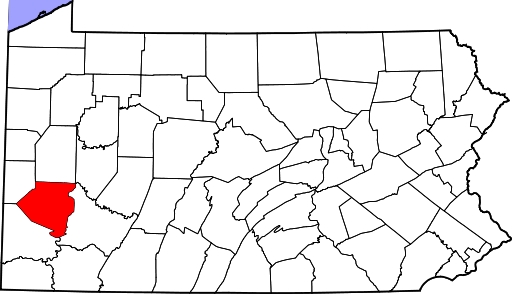
Allegheny County is located in southwestern Pennsylvania. Pittsburgh is the largest city in the county.
USDA Plant Hardiness Zones in Allegheny County, Pennsylvania
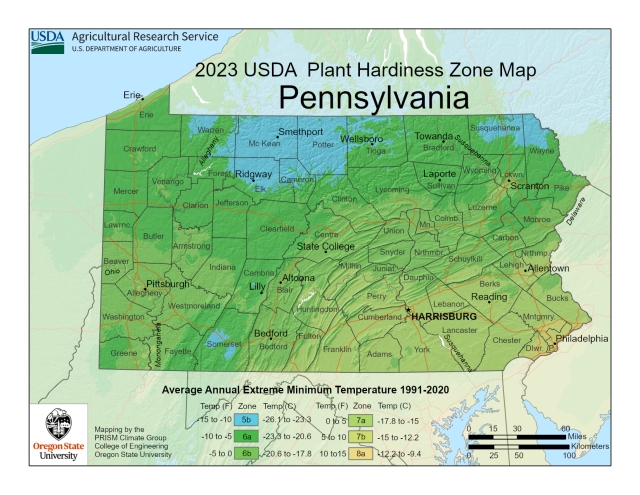
Allegheny County is located mostly within plant hardiness zone 6b. Adjacent to the Monongahela and Ohio Rivers is zone 7a. When selecting plants in Allegheny County, you will want to get those that can handle temperatures as cold as -50F.
Butterflies in Allegheny County, Pennsylvania that are hosted by Asters (Symphyotrichum spp.)
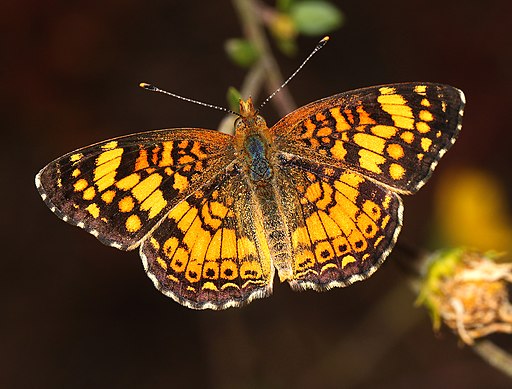
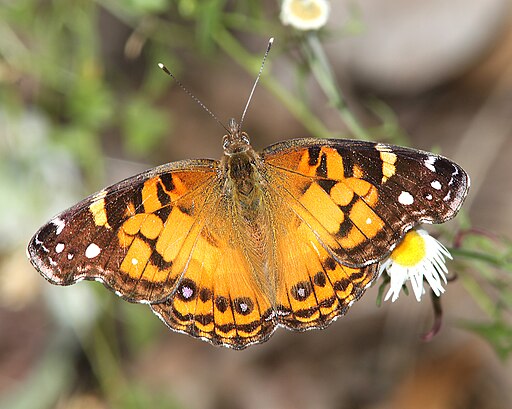
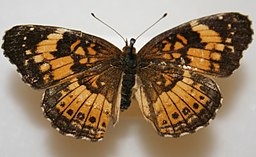
Pearl Crescent (Phycoides tharos)
The Pearl Crescent is a brown butterfly with distinctive orange to yellow markings on both the forewings and hindwings. Generally the males look more yellow and the females are more brown mottled and the summer broods can have less mottling (Bousemann and Sternburg 2001).
The eggs of this species are green and are laid underneath the leaves of asters. The caterpillars are brown, black to white with yellow on the sides and are bristly. The brownish chrysalis hangs from the host plant and the adults have a wingspan of 1 (2.5 cm) to 1.6 in (4.1 cm). They fly from April to November in the Allegheny County area.
American Lady (Vanessa virginiensis)
The American Lady is orange in the center with brown edges. The forewings show the typical white spots of the members of the Vanessa genus. In particular this species has a white dot on the forewing that serves to identify it.
The eggs of this species are yellow-green and barrel shaped (Pyle 1981). The caterpillars are black with yellow and white stripes and have rusty colored dots. The gold spotted chrysalis gives rise to an adult in the late spring with a wingspan of 1.75 in (4.4 cm) to 2.6 in (6.6 cm). The adults can fly into November with 3 to 4 broods in a year.
Silvery Checkerspot (Chlosyne nycteis)
The silvery checkerspot is a muted yellow-orange color with a dark brown edge and middle. The hindwings have white crescent shaped edges. Adults have a wingspan of 1.4 in (3.6 cm) to 3.5 in (8.9 cm).
The greenish-white eggs are laid on the underside of the host plant leaves. The caterpillar is black in color and has small white spots. On the sides there may be yellow or orange stripes. In the early spring (March) in the south and late spring (June) in the north the adults emerge in one or two broods.
List of Asters that are Native or Nearly Native in Allegheny County, Pennsylvania
1. Common Blue Aster (Symphyotrichum cordifolium), an Aster for Medium to Moist Soils
Common blue aster is a native plant to Allegheny County and thrives in medium to moist soils. In a garden individual plants need to be at least 1-2 ft apart to allow for air circulation. Once established, this species can tolerate droughts and is low maintenance. Possible companion plants will depend on the amount of sun present in the garden. Some general species include goldenrod (Solidago spp.), Joe-Pye weed (Eutrochium spp.), and coneflower (Echinacea purpurea). If you have sun, butterfly weed (Asclepias tuberosa), black-eyed susan (Rudbeckia hirta), and blazing star (Liatris spicata) can be added. If you have part-shade, bee balm (Monarda didyma), columbine (Aquilegia canadensis), and beardtongue (Penstemon spp.) can be added. Grasses such as switchgrass (Panicum virgatum) and little bluestem (Schizacharium scoparium).
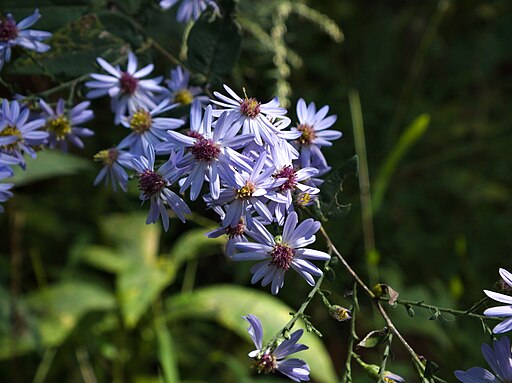
Facts about Common Blue Aster
- Native to Pennsylvania: Yes (Kartesz 2015)
- Native to Allegheny County: Yes
- Natural Habitat: wooded areas, thickets, roadsides, and moist banks
- Height: 1 ft (0.3 m) to 4 ft (1.2 m)
- Flower Color: blue, yellow (disk), purple, red to white
- Flowering Period: August to October
- USDA Hardiness Zone: 3-8
Gardening with Common Blue Aster
In your Allegheny County, PA butterfly garden this plant requires full sun to part shade and medium to moist soils. When planted it needs to be controlled since it can have weedy characteristics.
2. Drummond’s Aster (Symphyotrichum drummondii), an Aster for Well-Drained Soils
Drummond’s aster used to be present in Pennsylvania and in Allegheny County. However, this species can grow in the plant hardiness of the county. Plants should be planted in slightly acidic soils and spaced 1-2 feet apart to allow for adequate air circulation. Suitable companions to this species include butterfly weed (Asclepias tuberosa), black-eyed susan (Rudbeckia hirta), New England aster (Symphyotrichum novae-angliae), goldenrod (Solidago spp.), and Joe-Pye weed (Eutrochium spp.), and coneflower (Echinacea purpurea). Generally this plant enjoys full sun, but can tolerate partial shade.
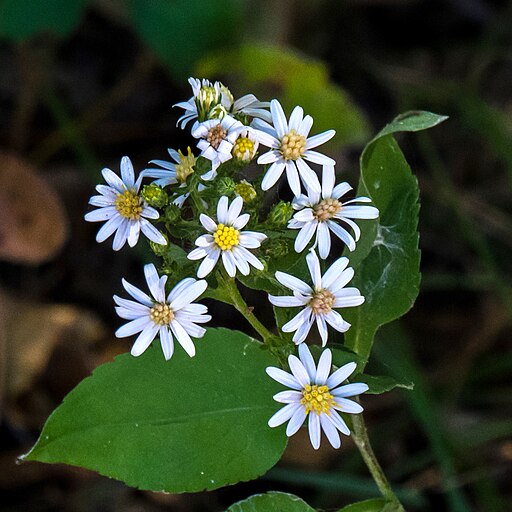
Facts about Drummond’s Aster
- Native to Pennsylvania: Yes, historic (Kartesz 2015)
- Native to Allegheny County: Yes, historic
- Natural Habitat: open woodlands and fields
- Height: 3 ft (0.9 m) to 4 ft (1.2 m)
- Flower Color: Ray: white, lavender to violet, Disk: yellow becoming brown
- Flowering Period: August to October
- USDA Hardiness Zone: 3-9
Gardening with Drummond’s Aster
In your Allegheny County, PA butterfly garden, this plant requires full sun to part shade and well-drained soils.
3. Smooth Blue Aster (Symphyotrichum laeve), an Aster for Medium to Dry Well-Drained Soils
Smooth blue aster is native to Allegheny County and is suitable for gardens that have full sun. Other companions that would like the sun include goldenrod (Solidago spp.), Joe-Pye weed (Eutrochium spp.), and coneflower (Echinacea purpurea). When looking for companion plants, just be sure to select those that can handle drier soils. Once planted this species requires little maintenance and makes an excellent compliment to the garden.
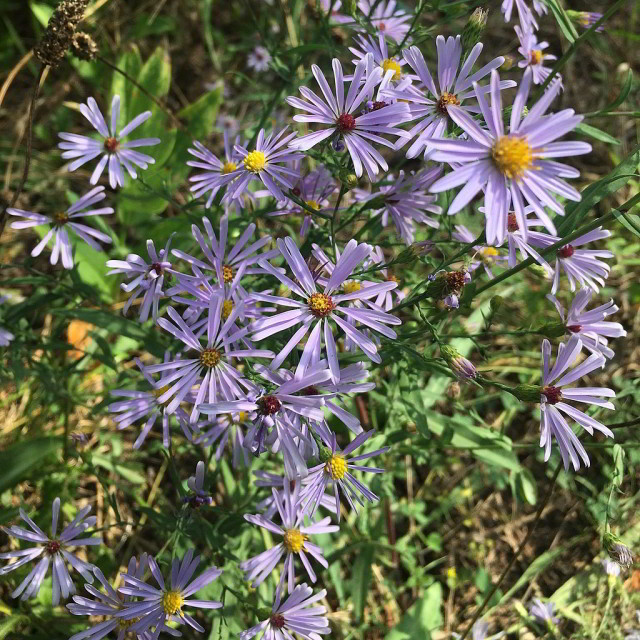
Facts about Smooth Blue Aster
- Native to Pennsylvania: Yes, throughout, except scattered in northwest (Kartesz 2015)
- Native to Allegheny County: Yes
- Natural Habitat: open woodlands and fields
- Height: 2 ft (0.6 m) to 3 ft (0.9 m)
- Flower Color: Ray: purple to lavender, Disk: yellow
- Flowering Period: September to October
- USDA Hardiness Zone: 4-8
Gardening with Smooth Blue Aster
In your Allegheny County, PA butterfly garden, this plant requires full sun and soils that are medium to dry and well-drained. In addition to the main butterflies, this species hosts the lynx flower moth (Schinia lynx).
4. White Panicled Aster (Symphyotrichum lanceolatum), an Aster for Moist Well-Drained Soils
White panicled aster, an Allegheny County native, can add a splash of white to your garden. Like a lot of the other asters, once established this species is fairly low maintenance. Given the soils and exposure, possible companion plants include swamp milkweed (Asclepias incarnata), common milkweed (Asclepias syriaca), blazing star (Liatris spicata), goldenrod (Solidago spp.), and Joe-Pye weed (Eutrochium spp.).
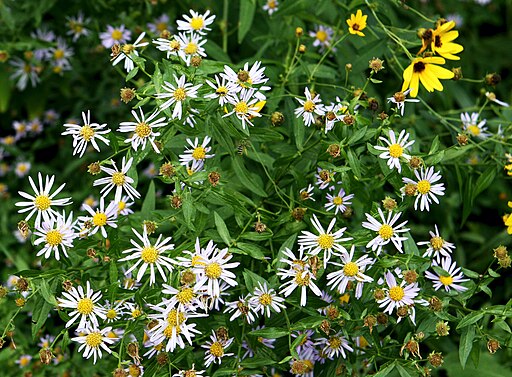
Facts about White Panicled Aster
Symphytotrichum lanceolatum subsp. lanceolatum var. interior, lanceolatum, and latifolium in Pennsylvania
- Native to Pennsylvania: Yes, throughout (Kartesz 2015)
- Native to Allegheny County: Yes
- Natural Habitat: open riparian areas, meadows, prairies, and ditches
- Height: 1 ft (0.3 m) to 5 ft (1.5 m)
- Flower Color: Ray: white ray flowers, Disk: yellow aging to orangish disk flowers
- Flowering Period: August to October
- USDA Hardiness Zone: 3-9
Gardening with White Panicled Aster
In your Allegheny County, PA butterfly garden, this plant requires full sun and soils that are moist and well-drained, but can handle poorly drained places.
5. Farewell Summer (Symphyotrichum lateriflorum), an Aster for Moist Well-Drained Soils having a high pH
Farewell summer is another Allegheny County native that thrives in moist soils, and can handle some shade if needed. Companion plants are very similar to those for the white panicled aster.
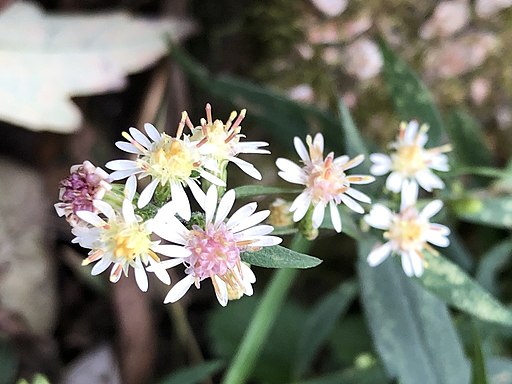
Facts about Farewell Summer
- Native to Pennsylvania: Yes, throughout (Kartesz 2015)
- Native to Allegheny County: Yes
- Natural Habitat: woodlands, wooded edges, meadows, and roadsides
- Height: 2 ft (0.6 m) to 3 ft (0.9 m)
- Flower Color: Ray: white, sometimes purple tinted, Disk: yellow, becoming pink to brown
- Flowering Period: August to October
- USDA Hardiness Zone: 4-8
Gardening with Farewell Summer
In your Allegheny County, PA butterfly garden, this plant requires full sun to partial shade and soils that are moist and well-drained.
6. New England Aster (Symphyotrichum novae-angliae), an Aster for Moist to Medium Well-drained Soils
New England aster, an Allegheny County native, is one of the prominent asters on the roadsides of Pennsylvania in the fall. It is one of the tallest asters in the state and can tower over a lot of other plants in your garden. Some companion plants that can reach and equal height to it include sweet-scented Joe-Pye weed (Eutrochium purpureum), New York ironweed (Vernonia novaboracensis), and yellow-cup (Silphium perfoliatum).
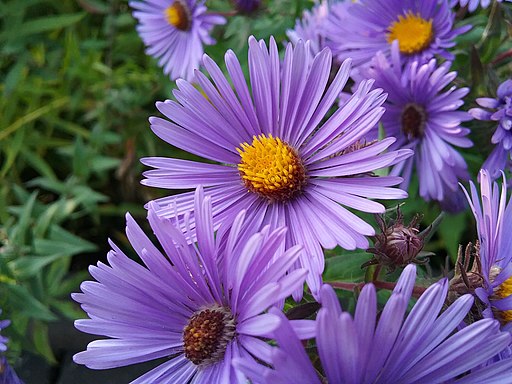
Facts about New England Aster
- Native to Pennsylvania: Yes, throughout (Kartesz 2015)
- Native to Allegheny County: Yes
- Natural Habitat: meadows, fields, disturbed areas, roadsides, and wooded edges
- Height: 3 ft (0.9 m) to 7 ft (2.1 m)
- Flower Color: Ray: rose to deep purple, Disk: yellow becoming purple
- Flowering Period: August to October
- USDA Hardiness Zone: 4-8
Gardening with New England Aster
In your Allegheny County, PA butterfly garden, this plant requires full sun and moist to medium well-drained soils.
7. New York Aster (Symphyotrichum novi–belgii), an Aster for Moist to Medium Well-drained Soils
New York Aster is rare in eastern Pennsylvania, but can exist in the plant hardiness zone of Allegheny County. It is a medium size aster that can provide a contrasting purple color to the New England Aster. This aster likes full sun, but can handle partial-shade. When planted, be sure to space plants 1-2 feet apart to allow for adequate air circulation. Companion plants that will provide a variety of color and textures include black-eyed susan (Rudbeckia hirta), switchgrass (Panicum virgatum), obedient plant (Physostegia virginiana), spotted Joe-Pye weed (Eutrochium maculatum), and phlox (Phlox paniculata).
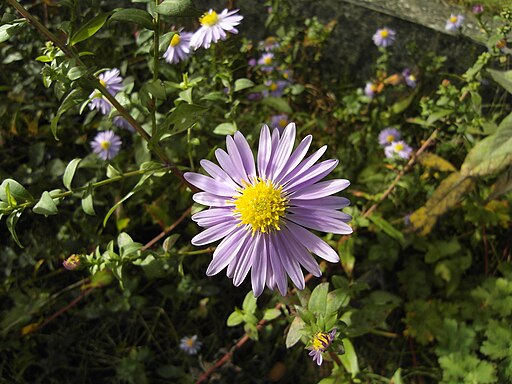
Facts about New York Aster
Symphyotrichum novi-belgii var. novi-belgii in Pennsylvania
- Native to Pennsylvania: Yes, rare in eastern counties and one central county (Huntingdon) (Kartesz 2015)
- Native to Allegheny County: No
- Natural Habitat: fields and meadows
- Height: 3 ft (0.9 m) to 5 ft (1.5 m)
- Flower Color: Ray: pink to purple, Disk: yellow
- Flowering Period: August to October
- USDA Hardiness Zone: 4-8
Gardening with New York Aster
In your Allegheny County, PA butterfly garden, this plant requires full sun and moist to medium well-drained soils. While rare in Pennsylvania, this species has a lot of cultivars and are often planted in pollinator gardens.
8. Aromatic Aster (Symphyotrichum oblongifolium), an Aster for Medium to Dry Rocky/Sandy Soils
Aromatic aster is native to Allegheny County and enjoys places with full sun and medium to dry well-drained soils. Its habitat of dry soils gives it the ability to withstand droughts. Plants can be divided every 3-4 years to increase the population. Suitable companion plants include little bluestem (Schizachyrium scoparium), sideoats grama (Bouteloua curtipendula), New England Aster (Symphyotrichum novae-angliae), prairie dropseed (Sporobolus heterolepis), and purple coneflower (Echinacea purpurea).
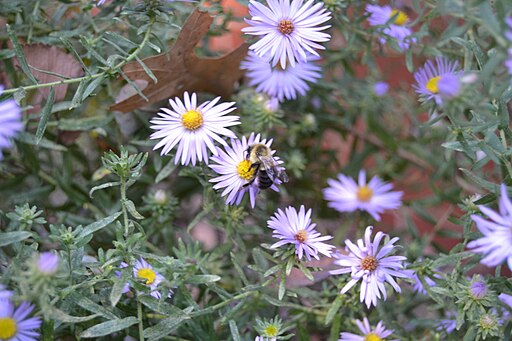
Facts about Aromatic Aster
- Native to Pennsylvania: Yes, central and southwestern counties (Kartesz 2015)
- Native to Allegheny County: Yes
- Natural Habitat: glades, prairies, cliffs, pastures, and roadsides
- Height: 1 ft (0.3 m) to 3 ft (0.9 m)
- Flower Color: Ray: lavender to deep purple, Disk: yellow becoming brown
- Flowering Period: August to November
- USDA Hardiness Zone: 3-8
Gardening with Aromatic Aster
In your Allegheny County, PA butterfly garden, this plant requires full sun and soils that are medium to dry and well-drained. This species can handle soils that are poor in quality.
9. Late Purple Aster (Symphyotrichum patens), an Aster for Medium to Dry Well-drained Soils
Late purple aster, also called aromatic aster, is native to Allegheny County, but has a scattered distribution in the western part of the state. This aster can handle full sun or partial-shade and needs medium to dry soils that are slightly acidic. Plenty of space is needed between plants to allow for air circulation. Companion plants that will provide some interest in the garden include bee balm (Monarda didyma), yarrow (Achillea millefolium), black-eyed susan (Rudbeckia hirta), purple coneflower (Echinacea purpurea), and Joe-Pye weed (Eutrochium fistulosum).
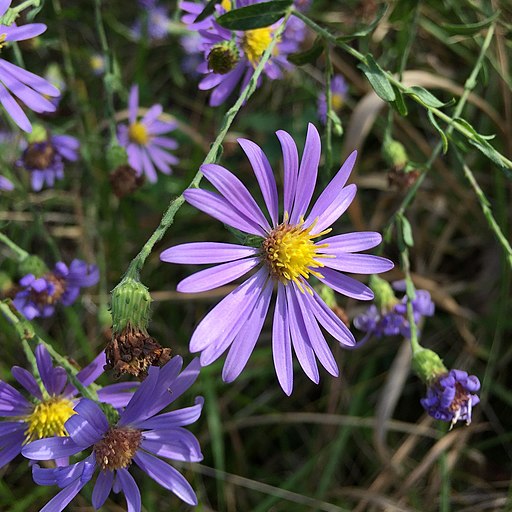
Facts about Late Purple Aster
Symphyotrichum patens var. patens in Pennsylvania
- Native to Pennsylvania: Yes, throughout, except scattered in western counties (Kartesz 2015)
- Native to Allegheny County: Yes
- Natural Habitat: open woods, fields, roadsides, and thickets
- Height: 2 ft (0.6 m) to 3 ft (0.9 m)
- Flower Color: Ray: white, blue, light-lavender to reddish-purple, Disk: yellow to cream becoming purple
- Flowering Period: August to October
- USDA Hardiness Zone: 4-8
Gardening with Late Purple Aster
In your Allegheny County, PA butterfly garden, this plant requires full sun to part-shade and soils that are medium to dry and well-drained. This species also attracts a lot of Andrena bees.
10. Phlox-leaf Aster (Symphyotrichum phlogifolium), an Aster for Medium to Dry Well-drained Soils
Phlox-leaf aster is native to Allegheny County and is a unique aster in that it has white disk flowers, a trait it shares with the Georgia aster. This aster likes full sun to part-shade and neutral soils around a pH of 7.0. It is important to have enough space between plants for air circulation. Suitable companion plants include coreopsis (Coreopsis spp.), sedum (Sedum spp.), switchgrass (Panicum virgatum), and shrubby St. John’s Wort (Hypericum prolificum).
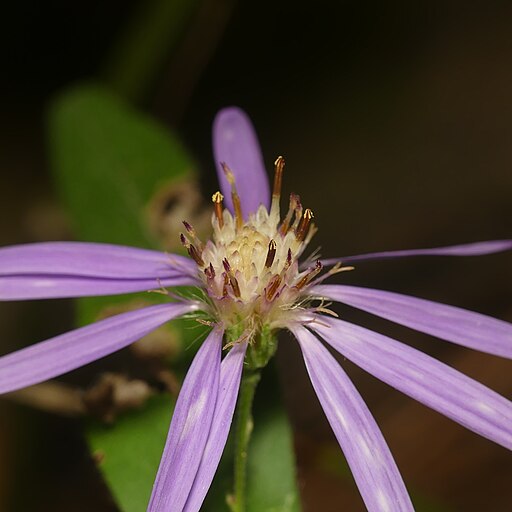
Facts about Phlox-leaf Aster
- Native to Pennsylvania: Yes, southern counties (Kartesz 2015)
- Native to Allegheny County: Yes
- Natural Habitat: forests and roadsides
- Height: 1 ft (0.3 m) to 4 ft (1.2 m)
- Flower Color: Ray: light to dark reddish-purple to purple, Disk: white with purplish tint
- Flowering Period: August to October
- USDA Hardiness Zone: 3-8
Gardening with Phlox-leaf Aster
In your Allegheny County, PA butterfly garden, this plant requires full sun to part-shade and soils that are medium to dry and well-drained.
11. White Old Field Aster (Symphyotrichum pilosum), an Aster for Moist Well-drained Soils
White old field aster is another sun loving Allegheny County native. Besides the sun, this species likes soils that are neutral to slightly acidic. Seeds can be planted in the fall before the first frost or in the spring after the last frost. This species needs to be watered during drought periods as it can be sensitive to dryness. Plants that compliment this species in the garden include goldenrod (Solidago spp.), New England Aster (Symphyotrichum novae-angliae), butterfly milkweed (Asclepias tuberosa), little bluestem (Schizachyrium scoparium), and anise hyssop (Agastache foeniculum).
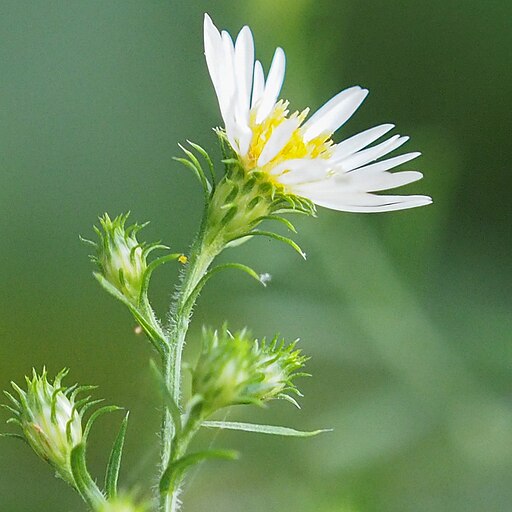
Facts about White Old Field Aster
Symphyotrichum pilosum var. pilosum and var. pringlei in Pennsylvania
- Native to Pennsylvania: Yes, throughout (Kartesz 2015)
- Native to Allegheny County: Yes
- Natural Habitat: fields, pastures, roadsides, and open areas
- Height: 2 ft (0.6 m) to 4 ft (1.2 m)
- Flower Color: Ray: white to pinkish or bluish, Disk: yellow becoming reddish purple
- Flowering Period: September to October
- USDA Hardiness Zone: 4-8
Gardening with White Old Field Aster
In your Allegheny County, PA butterfly garden, this plant requires full sun to part-shade and soils that are moist and well-drained. This species has been noted as being weedy, so it may need to be controlled. It is also attractive to moths.
12. Willow-leaf Aster (Symphyotrichum praealtum), an Aster for Moist and Well-drained Soils
Willow-leaf aster is yet another Allegheny County native that enjoys full sun and moist soils. It can add to the diversity of asters with purple flowers and has similar to companion plants and requirements as the white old field aster above.
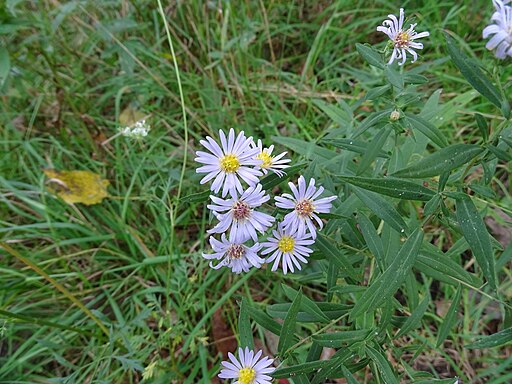
Facts about Willow-leaf Aster
- Native to Pennsylvania: Yes, rare throughout, except for the central counties (Kartesz 2015)
- Native to Allegheny County: Yes
- Natural Habitat: open woods, fields, thickets, roadsides, and moist areas
- Height: 2 ft (0.6 m) to 5 ft (1.5 m)
- Flower Color: Ray: white, light blue-violet to rose-purple, Disk: cream to yellow becoming pink-purple
- Flowering Period: August to October
- USDA Hardiness Zone: 4-8
Gardening with Willow-leaf Aster
In your Allegheny County, PA butterfly garden, this plant requires full sun and part shade and soils that are moist and well-drained.
13. Crooked-Stem Aster (Symphyotrichum prenanthoides), an Aster for Moist to Medium Well-drained Soils
Crooked-stem aster is an aster that you may already have in your garden and if you do, you likely have a lot of it. It can be weedy, but is an excellent bee magnet when paired with various goldenrods (Solidago spp.) in the late summer and early fall. While native to Allegheny County, this species may experience heat stress in the future since it is near the upper end of its hardiness zone.
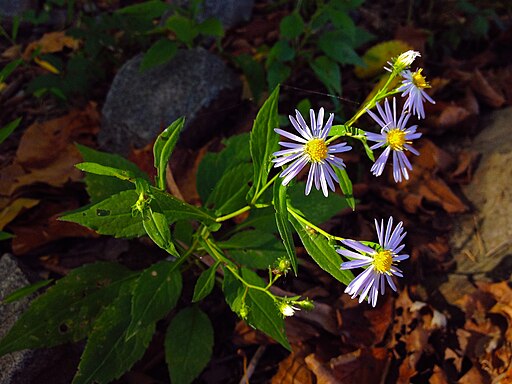
Facts about Crooked-Stem Aster
- Native to Pennsylvania: Yes, throughout (Kartesz 2015)
- Native to Allegheny County: Yes
- Natural Habitat: forest edges, roadsides, wetlands
- Height: 1 ft (0.3 m) to 4 ft (1.2 m)
- Flower Color: Ray: white, lavender to blue, Disk: cream to yellow becoming brown
- Flowering Period: August to October
- USDA Hardiness Zone: 4-7
Gardening with Crooked-Stem Aster
In your Allegheny County, PA butterfly garden, this plant requires full sun to part shade and soils that are medium to dry and well-drained. This species is a favorite of Andrena bees. In the future crooked-stem aster may face increased heat stress in the future due to climate induced warming since it is near the upper limit of its plant hardiness in Allegheny County. This aster has a tendency to be weedy, which has been noticed in the McMullen gardens.
14. Purple-Stem Aster (Symphyotrichum puniceum), an Aster for Moist to Medium Well-drained Soils
Purple-stem aster, also known as the swamp aster, like a number of other asters is native to Allegheny County and likes places of full sun, but handles partial-shade. Soils should be slightly acidic to around neutral. Keeping this species watered will result in impressive floral displays. Other species that compliment this one the garden include: switchgrass (Panicum virgatum), obedient plant (Physostegia virginica), ironweed (Vernonia novaboracensis), blazing star (Liatris spicata), and sweet Joe-Pye weed (Eutrochium purpureum).
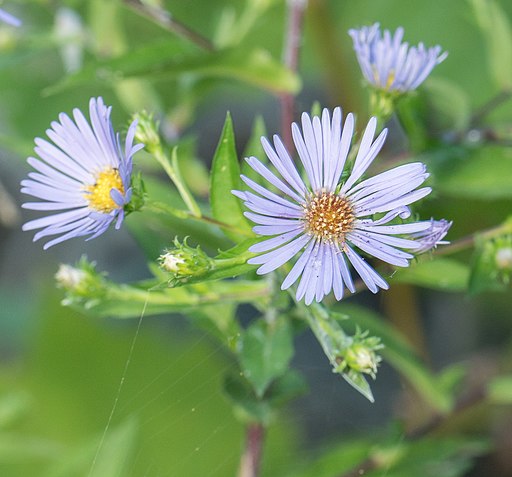
Facts about Purple-Stem Aster
Symphyotrichum puniceum var. puniceum in Pennsylvania
- Native to Pennsylvania: Yes, throughout (Kartesz 2015)
- Native to Allegheny County: Yes
- Natural Habitat: forest edges, roadsides, wetlands
- Height: 6 ft (1.8 m) to 8 ft (2.4 m)
- Flower Color: Ray: Dark blue, purple, to white, Disk: cream to yellow becoming pink to purple
- Flowering Period: August to October
- USDA Hardiness Zone: 2-9
Gardening with Purple-Stem Aster
In your Allegheny County, PA butterfly garden, this plant requires full sun and soils that are medium to moist and well-drained.
15. Fragile-Stem Aster (Symphyotrichum racemosum), an Aster for Moist Soils
If you have a wet spot in your garden this may be your aster. While not native to Allegheny County, fragile-stem aster grows in the plant hardiness zone. The small, feathery leaves give an interesting texture to the garden. Plants that compliment this species include goldenrod (Solidago spp.), black-eyed susan (Rudbeckia fulgida), and prairie dropseed (Sporobolus heterolepis), and Virginia bluebell (Mertensia virginica) and wild geranium (Geranium maculatum) in shaded places.
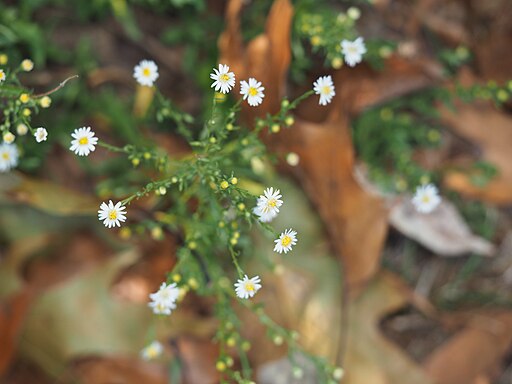
Facts about Fragile-Stem Aster
- Native to Pennsylvania: Yes, southeast and northwestern counties (Kartesz 2015)
- Native to Allegheny County: No
- Natural Habitat: wetlands such as marshes, wet meadows, swamps, prairies, and bogs
- Height: 1 ft (0.3 m) to 3 ft (0.9 m)
- Flower Color: Ray: white to pink, Disk: cream to yellow becoming pink to red
- Flowering Period: August to October
- USDA Hardiness Zone: 4-8
Gardening with Fragile-Stem Aster
In your Allegheny County, PA butterfly garden, this plant requires full sun and moist soils.
16. Short’s Aster (Symphyotrichum shortii), an Aster for Medium to Dry Soils
Short’s aster, an Allegheny County native, can provide a combination of purple and white bridging the colors of the asters in your garden. This species is versatile and can handle full sun or full shade in medium to dry soils that are slightly alkaline. Overcrowding can be controlled by dividing the plants every 3 to 5 years. Interesting companion plants include blanket flower (Gaillardia aristata), threadleaf coreopsis (Coreopsis verticillata), common milkweed (Asclepias syriaca), beebalm (Monarda didyma), and stonecrop (Sedum spp.).
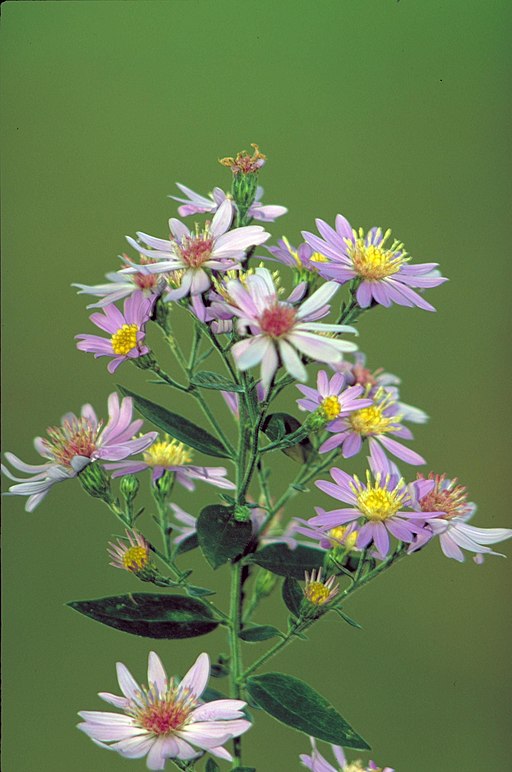
Facts about Short’s Aster
- Native to Pennsylvania: Yes, central and western counties (Kartesz 2015)
- Native to Allegheny County: Yes
- Natural Habitat: woodlands, wooded edges, stream banks, and roadsides
- Height: 2 ft (0.6 m) to 4 ft (1.2 m)
- Flower Color: Ray: light blue to lavender or white, Disk: yellow becoming reddish-purple
- Flowering Period: August to October
- USDA Hardiness Zone: 3-8
Gardening with Short’s Aster
In your Allegheny County, PA butterfly garden, this plant requires full sun to full shade and soils that are medium to dry and well-drained. This species is a favorite of Andrena bees and a number of moth species. Based on its natural habitat it may like soils that are circumneutral or above.
17. Wavy-leaf Aster (Symphyotrichum undulatum), an Aster for Dry Well-drained Soils
If you have drier soils and a full sun to partial-shade exposure, wavy-leaf aster may be a species to consider. An Allegheny County native, it is best to plant this species in the fall to allow time for the roots to develop. Companion plants include New York ironweed (Vernonia novaboracensis), smooth blue aster (Symphyotrichum laeve), big bluestem (Andropogon gerardii), and Indian grass (Sorghastrum nutans).
Facts about Wavy-leaf Aster
- Native to Pennsylvania: Yes, throughout (Kartesz 2015)
- Native to Allegheny County: Yes
- Natural Habitat: woodlands, fields, sandhills
- Height: 1 ft (0.3 m) to 5 ft (1.5 m)
- Flower Color: Ray: light blue to purple, Disk: cream to light yellow becoming purple
- Flowering Period: August to October
- USDA Hardiness Zone: 4-9
Gardening with Wavy-leaf Aster
In your Allegheny County, PA butterfly garden, this plant requires full sun to part shade and soils that are dry and well-drained.
18. White-arrow Aster (Symphyotrichum urophyllum), an Aster for Medium to Dry Sandy/Rocky Well-drained Soils
If you have a rock garden, white-arrow aster is for you. An Allegheny County native this species requires full sun to part-shade and dry soil. Suitable companion plants include switchgass (Panicum virgatum), mistflower (Conoclinum coelestinum), river-oats (Chasmanthium latifolium), and frostweed (Verbesina virginica).
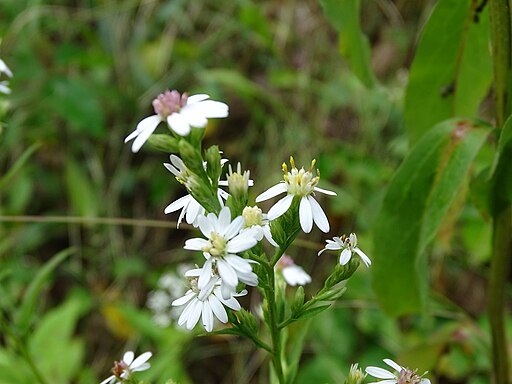
Facts about White-arrow Aster
- Native to Pennsylvania: Yes, throughout, except northeastern and south-central counties (Kartesz 2015)
- Native to Allegheny County: Yes
- Natural Habitat: woodlands, wooded edges, fields, roadsides, and railroads
- Height: 1 ft (0.3 m) to 4 ft (1.2 m)
- Flower Color: Ray: white, pink, light blue, Disk: cream, yellow to white becoming pinkish
- Flowering Period: August to October
- USDA Hardiness Zone: 4-8
Gardening with White-arrow Aster
In your Allegheny County, PA butterfly garden, this plant requires full sun to part shade and soils that are medium to dry, sandy/rocky and well-drained.
Author’s Bio: Robert Coxe is the owner of McMullen House Bed & Breakfast LLC and Silphium Design LLC (a web development firm). Robert has a graduate degree in systematic botany and ecology and is the former State Ecologist of Delaware and a former ecologist at the Western Pennsylvania Conservancy. He is also a past-president of the Pennsylvania Academy of Science. Robert has a blog about native plant and butterfly gardens at the McMullen House Bed & Breakfast Garden Shop.
